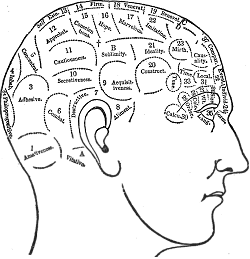 It’s not about bumps any more. And you’ll look in vain for old friends like the area of philoprogenitiveness. But looking at the brightly-coloured semantic maps of the new ‘brain dictionary‘ it’s hard not to remember phrenology.
It’s not about bumps any more. And you’ll look in vain for old friends like the area of philoprogenitiveness. But looking at the brightly-coloured semantic maps of the new ‘brain dictionary‘ it’s hard not to remember phrenology.
Phrenology was the view that different areas of the brain were the home of different personal traits; mirth, acquisitiveness, self esteeem and so on. The size of these areas corresponded with the strength of the relevant propensity and well-developed areas produced bumps which a practitioner could identify from the shape of the skull, allowing a diagnosis of the subject’s personality and moral nature. Phrenology was bunk, of course; but come on now; we shouldn’t treat it as a pretext for dismissing every proposal for localisation of brain function..
Moreover, the new paper by Alexander G. Huth, Wendy A. de Heer, Thomas L. Griffiths, Frédéric E. Theunissen and Jack L. Gallant describes a vastly more sophisticated project than some optimistic charlatan fingering heads. In essence it maps a semantic domain on to the cortex, showing which areas are found to be active when a heard narrative ventures into particular semantic areas. In broad outline the subjects listened to a series of stories; using fMRI and through some sophisticated analysis it was possible to produce a map of ‘subject’ areas. It was then possible to confirm the accuracy of the mapping by using a new story and working out which areas, according to the mapping, should be active at any point; the predictions worked well. Intriguingly the map turned out to be broadly symmetrical (so much for left-brain/right-brain ideas) and remarkably it was largely the same across all the people tested (there were only seven of them, but still).
The actual technique used was complex and it’s entirely possible I haven’t understood it correctly. It started with a ‘word embedding space’ intended to capture the main semantic features of the stories (a diagram of the different topics, if you like). This was created using an analysis of co-occurence of a list of 985 common English words. The idea here is that words that crop up together in normal texts are probably about the same general topic. It’s debatable whether that technique can really claim to capture meaning – it’s a purely formal exercise performed on texts, after all; and clearly the fact that two words occur together can be a misleading indication that they are about the same thing; still, with a big enough sample of text it’s probably good for this kind of general purpose. In principle the experimenters could have assessed the responsive ness of each ‘voxel’ (a small cube) of brain to each of the positions in the word embedding space, but given the vast number of voxels involved other techniques were necessary. It was possible to identify just four dimensions that seemed significant (after all, many of the words in the stories probably did not belong to specific semantic domains but played grammatical or other roles) and these yielded 12 categories:
…‘tactile’ (a cluster containing words such as ‘fingers’), ‘visual’ (words such as ‘yellow’), ‘numeric’ (‘four’), ‘locational’ (‘stadium’), ‘abstract’ (‘natural’), ‘temporal’ (‘minute’), ‘professional’ (‘meetings’), ‘violent’ (‘lethal’), ‘communal’ (‘schools’), ‘mental’ (‘asleep’), ‘emotional’ (‘despised’) and ‘social’ (‘child’).
The final step was to devise a Bayesian algorithm (they called it ‘PrAGMATIC’) which actually created the map. You can play around with the results for yourself at a specially created site using the second link above.
Two questions naturally arise. How far should we trust these results? What do they actually tell us?
A bit of caution is in order. The basis for these conclusions is fMRI scanning, which is itself a bit hazy; to get meaningful results it was necessary to look at things rather broadly and to process the data quite heavily. In addition the mix included the word embedding space which in itself is an a priori framework whose foundations are open to debate. I think it’s pardonable to wonder whether some of the structure uncovered by the research was actually imported by the research method. If I understand the methods involved (due caveat again) they were strong ones that didn’t take ‘no’ for an answer; pretty much any data fed into them would yield a coherent mapping of some kind. The resilience of the map was tested successfully with an additional story of the same general kind, but we might feel happier if it had also held up when tested against conversation, discussion or even other story media such as film.
What do the results tell us? Well. one of the more reassuring aspects of the research is that some of the results seem slightly unexpected; the high degree of symmetry and the strong similarity between individuals. It might not be a tremendously big surprise to find the whole cortex involved in semantics, and it might not be at all surprising to find that areas that relate to the semantics of a particular sense are related to the areas where the relevant sensory inputs are processed. I would not, though, have put any money on the broad remainder of the cortex having what seems like a relatively static organisation and if it really works like that we might have guessed that studies of brain lesions would have revealed that more clearly already, as they have done with various functional jobs. If one area always tends to deal with clothing-related words, you might expect notable dress-related deficits when that area is damaged.
Still there’s no denying that the research seems to activate some pretty vigorous cortical activity itself.

i hit my head